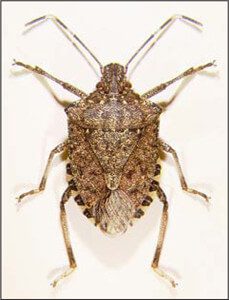
Adult brown marmorated stink bugs have bodies in the shape of a shield. They are typically five eighths of an inch long and three eighths of an inch wide. In September, adult stink bugs begin flying to their overwintering sites. Those sites are usually very protected and inside houses and other buildings. In May they will awaken and feed for two weeks before mating.
As far as controlling the brown marmorated stink bug, there is still very little research from which to devise strategies. Pesticides need to be tested and data collected. In order to keep the brown marmorated stink bug out of homes and buildings, simply ensure that all cracks are sealed. Openings around windows, doors, and AC units should be sealed with caulk. Do not use insecticides inside as they will not prevent them from returning and can be dangerous for humans and pets.

